Austin Game Conference and Women's Game Conference 2004 Report
|
|
ADVERTISEMENT |
The 2nd annual Austin Game Conference took place at the Austin Convention Center on September 9th and 10th. The first Women's Game Conference - also organized by The Game Initiative (the people behind AGC) - took place at the same time. Both conferences were well attended, with over 1400 total attendees - up from around 850 people last year. The Austin Game Conference is shaping up to be a very important event in the game indusrty, providing not only high quality conference sessions, but a quiet and comfortable place to talk to other developers.
Several representatives of GameDev.net were at the conference this year, with John Hattan and Sande Chen providing the following summaries of the sessions they attended, as well as their overall impressions of the conference.
Dave Astle
Executive Producer
GameDev.net
John
Nokia had a lot of sponsored sessions where they sold developers not only on their phones but also on their development programs. Nokia's had a free developer program for quite some time at forum.nokia.com, but they're now selling a new "premium" developer service for about $3,800 a year. Unfortunately, the benefits of this program mostly consisted of discounts for their "pay by the week" tech support services.
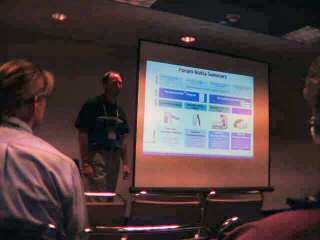
Funniest was the list of goodies you get for signing up to the program. In addition to the expected SDK discs and documentation, you also get several Nokia-branded trinkets, including a knife. Having recently completed a J2ME project, I can truthfully say that giving sharp objects to people in the throes of J2ME development is not a good idea.

I originally intended this photo to be an example of some of the ridiculous stuff people put in PowerPoint slides so that the slide doesn't look too sparse. There's just a little text on this slide, so the author stuck in what appears to be a large blue translucent bean covering the left half of the screen, conveying no information whatsoever.
Getting a second look at it, though, it looks more like a scene from the up-coming movie Dawn Of The Male Pattern Baldness Zombies.
. . .when there is no Rogaine in Hell, the dead will walk the Earth!

The Expo Hall was a much more sedate affair than the kind of stuff you see at the GDC. There were about 20 booths, only about half of which were the kind of places that'd spend the big bucks to get a GDC-booth. No booth-bims in sight.
It did make the whole affair much easier to navigate, though.

Graft was, also expectedly, quite sparse. Configuration Management companyPerforce had little wooden toy planes to show off.

ATI showed off their new mobile chipset. This little prototype brick is running a tiny mini-PC and ATI's mobile 3D graphics chip. The upper-left corner is a little gameboy-sized screen showing a beautiful rotating animated chessboard. Apparently these chips are being soldered into mobile-phones even as we speak, so you'll likely start seeing some impressive phone-games soon.
. . .although you shouldn't hold your breath for mobile-phone-Halo quite yet. The main processor and memory in the phones are still very limited, so there'll be big bottlenecks for all but the most rudimentary content. If 3D gets pressed into phone-service in the near-term it'll probably be used more in 3D GUI's and making enhanced 2D games and simple "applet-style" 3D games.
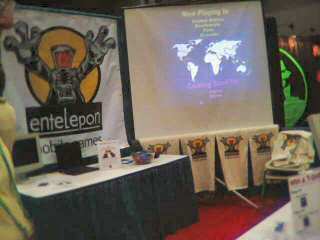
I think this was my favorite booth in the whole place. Mobile developerEntelepon was on hand to show off what will undoubtedly be the killer phone-app of 2004 and 2005 --Massively Multiplayer Snake!
Okay, calling it "Massively" multiplayer is a bit of a misnomer, as there appeared to only be about five snakes at a time in a world, but I still think it's a brilliant move to take something as ubiquitous as the classic Snake game and adding a network twist.
It's currently running on BREW-phones, with a J2ME version on the horizon.
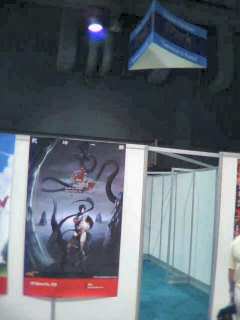
By far the largest booth (but still a bit small compared to GDC standards) was the Korean pavilion. They had plenty of cool games to show off and a small lounge area where you could shmooze with Korean publishers. Apparently MMORPG-type games are absolutely enormous in Korea, so you oughta give those folks a look if you're planning to network your game.

And finally here's your intrepid Gamedev COO (on the right) talking with his manager, undoubtedly planning the latest and hottest bleeding-edge mobile technologies. I'm surprised I didn't have to sign an NDA just in case I overheard something.
Sande
Women's Game Conference, Thursday
Getting to the Top
Three high-ranking women executives, Ellen Guon Beeman (Live Team Producer, The Matrix Online, Monolith), Kathy Schoback (Vice President, Content Strategy, Infinium Labs), and Laura Fryer (Director, Advanced Technology Group, Microsoft Corporation), described the path their lives have taken on the journey to positions of power in the game industry. All mentioned an interest in early games like D&D or Air Warrior. The stories were interesting because they had all worked during the early days of the game industry. They discussed the challenges of balancing personal life with work, especially the issue of child-rearing.
Roundtable Sessions
The rest of the day was spent in roundtables to discuss pertinent questions facing women in the industry today. The results of these discussions will be posted online, presumably at the Women's Game Conference site. Some of the questions tackled: How to attract young women into the sciences?; What is the benefit of women employees? What game concepts appeal to women? Etc.
Women's Game Conference, Friday
The Right Man For The Job May Be A Woman… But How Do We Find Her?
Clarinda Merripen (Director of Operations, Cyberlore) moderated this panel consisting of Ellen Guon Beeman (Live Team Producer, The Matrix Online, Monolith), Robin McShaffrey (Recruiter, Mary-Margaret.com), Linda Powers (HR Director, NCSoft) and Margaret Wallace (CEO, Skunk Studios). While it is illegal to specifically advertise for diversity candidates, there are certain tricks HR people can do to widen the scope of candidates. McShaffrey suggested that it might be worth it to pay recruiter fees for mid to upper tier employees and that women in related fields, such as film and television, are often good fits for the game industry. Powers of NCSoft mentioned that most vacancies at NCSoft were filled with "word of mouth" candidates and stressed the importance of networking. Merripen noticed that even changing the wording from "developer" to "man or woman" can make an impact. While HR people can post in non-traditional places other than Gamasutra like girl gamer sites or the WIGD mailing list, the onus is ultimately on the candidate to be assertive and determined. The game industry requires this kind of stick-to-it-ness.
Austin Game Conference, Thursday
Monetizing the Masses: What are online players willing to pay for?
I had not looked closely enough at the program to see that the Future of the Development Pipeline was a special sponsored track. So, I was a little disappointed that the session became a promo/advertisement spot for GameTrust. GameTrust's Adeo Ressi, despite a PowerPoint mishap, presented some interesting data based on his company's analysis of 15 leading providers of casual games. An important point that Ressi stressed was about what he called the "fading spotlight" for new downloadable games. He estimated that each new game gets one week of top line promotion to sink or swim. If the title fails to catch the attention of the buying public, then it is often relegated to the online equivalent of shelf space. GameTrust, based in New York, provides focus group data for developers with clear quantitative feedback and a distribution channel to 55 million people.
Austin Game Conference, Friday
Keynote: Virtual Property in the Age of Wonder
Edward Castronova, Associate Professor of Telecommunications at Indiana University, used to have the opinion that the trading of fantasy world items was a natural development of free trade in cyberspace. But now he believes that as in certain cases of negative externalities such as pollution, societal welfare may not be well served by market forces that disrupt the awe and mysticism that is part of the MMORPG experience.
Military Applications for Online Gaming
Craig Fryar (Online Alchemy) moderated this panel consisting of Steve Blankenship (Total Immersion Software), Mike Sellers (Online Alchemy), Douglas Whatley (Breakaway Games), Bill Fergusen (BBN), and Major Roger Arias (Destineer). The panel members all represent game companies that either develop training simulations exclusively for the military or have supplemented their entertainment lines with contract work for the military. This insightful session discussed the cultural differences between working for the government versus the game industry and illuminated how training software may not be entertainment value. Rather, the excitement from the government has been from seeing the potential in entertainment titles to be modified for its own uses. Developing for the military appeals to game companies because the steady contract work can balance out the unpredictability of the game industry. Network is key to getting the contracts.
Beyond Episodic Structure: Time-Shifting Storytelling and Other Content Delivery
Lee Sheldon, a last-minute addition to the conference, described the pitfalls of a MMO episodic delivery schedule and argued instead for a content delivery structure that was more akin to that of daytime soap operas. Scheduling dates to deliver new content, such as Asheron's Call monthly changes, gives several problems: No foreshadowing within the story (since content magically appears), player population spikes around the release date, server strain, and formulaic story structure. Such a regular schedule undermines player retention because players do not have any incentive to stick around after the new content has been consumed. Scaling content and delivering it at unannounced times in smaller episodes instead teases the player and shortens the gap between story changes without causing disruptions.
General Impressions
There was some confusion as to whether a pass allowed attendees to go to both conferences. The conferences were staggered 30 minutes apart, so to attend an AGC session, one had to duck out of a WGC one midway. It was a pleasant surprise to find international attendees at such a small conference. Perhaps this is what GDC was like before the hoards of masses descended upon it. AGC is good for networking because you can't help but see the same people wandering around. It's fairly easy to assemble a dinner posse or to crowd around at the front and get into a conversation. Still, without a cell phone, I found it impossible to meet up with former acquaintances. It was great to be in Austin and I had oodles of fun.
Photos
Courtesy Javier O'Neill
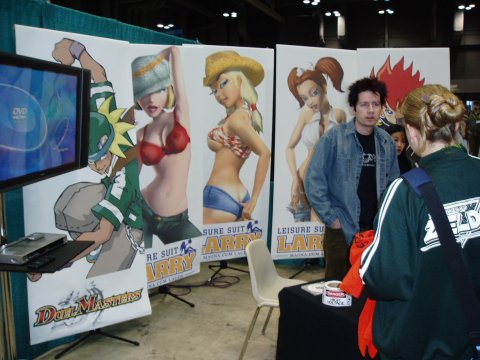
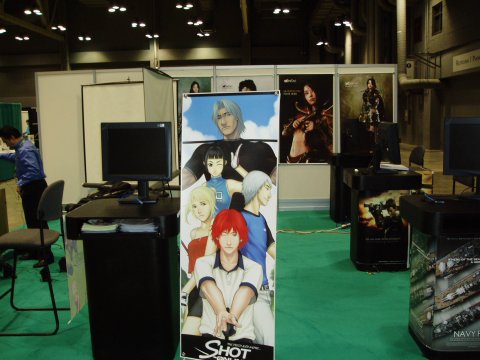


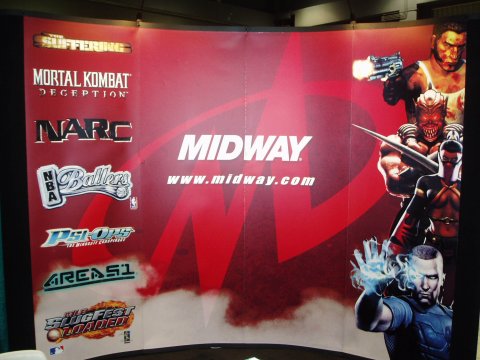
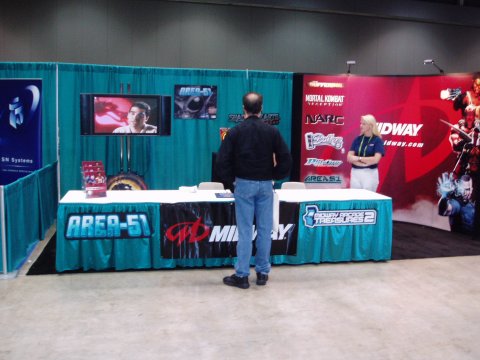
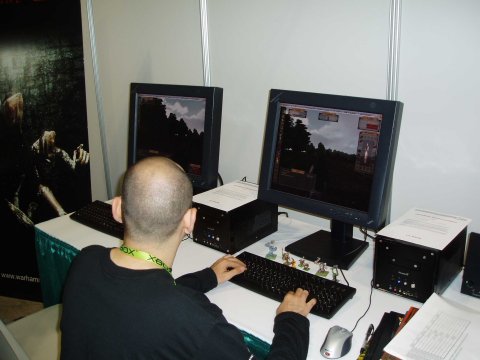
Discuss this article in the forums
Date this article was posted to GameDev.net: 9/27/2004
(Note that this date does not necessarily correspond to the date the article was written)
See Also:
Event Coverage
Event Coverage
© 1999-2011 Gamedev.net. All rights reserved. Terms of Use Privacy Policy
Comments? Questions? Feedback? Click here!